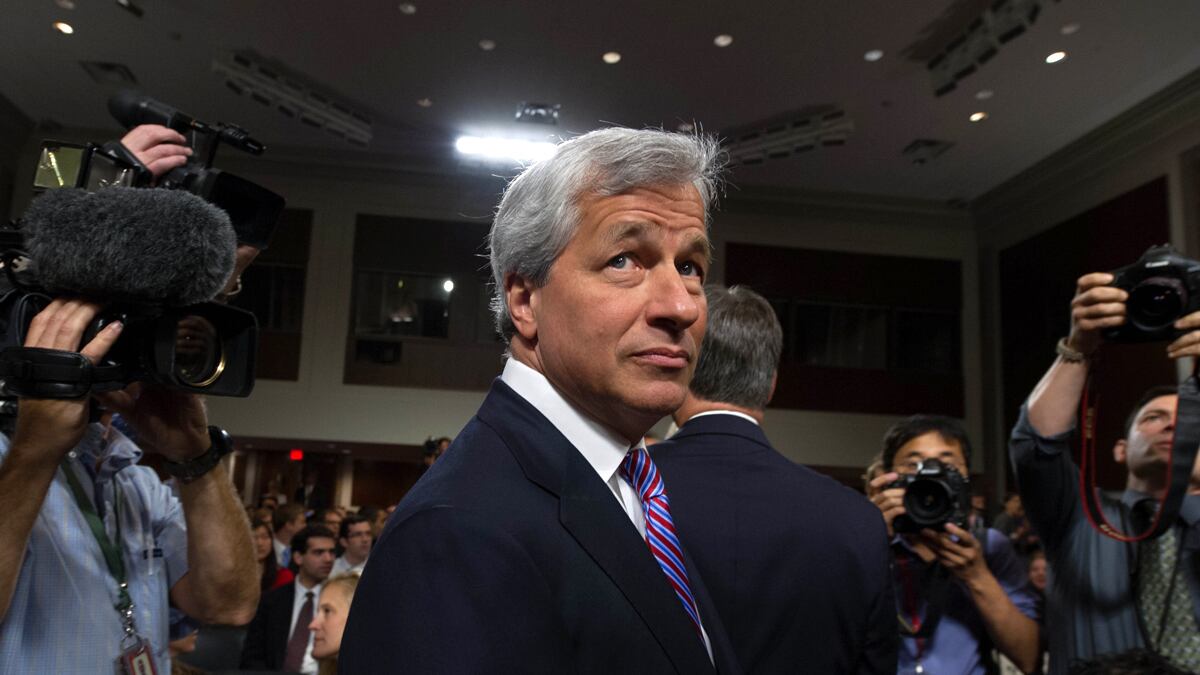Seven billion dollars.
That’s the difference between what JPMorgan Chase chief Jamie Dimon initially said his London office lost—$2 billion—in a botched trade and the amount the company might actually have lost: $9 billion, according to a report in today’s New York Times. When the bank discloses its second-quarter earnings on July 13, that red number could outweigh all the black. The bank posted a $5.4 billion profit in the first quarter of 2012.
Regulators aren’t happy. Critics says JPMorgan’s complicated “hedging” strategy is really just a creative way to make speculative bets with customer money. Calling them hedges, ostensibly risk-management moves, puts the bank squarely in a mile-wide loophole within the Volcker Rule, which is supposed to prohibit naked proprietary trading. Under the Dodd-Frank Act, you’re not allowed to flip deposit accounts into risky, high-yield securities any longer. But, if appropriately framed as a “hedge,” a large bank could technically be in the clear.
“Essentially, JPMorgan has been operating a hedge fund with federal insured deposits within a bank,” Mark Williams, a former Federal Reserve bank examiner, told The New York Times.
JPMorgan enjoyed a reputation for competence throughout the financial crisis, and Jamie Dimon had been anointed by some as “Wall Street’s golden boy.” But, in past weeks, he has had to face congressional grilling, as well as shareholder angst. Conversely, former Wall Street whipping boy Goldman Sachs has seen the heat die down.
The Fed is now trying to figure out independently just how much JPMorgan lost, while hedge funds, which have freer reign to trade risky securities, are swarming to take the other side of Dimon’s disastrous position. As for the stock market, the heightened loss estimates made for a glum start to the trading day.

Meanwhile, across the pond, another big bank is facing a bottom-line hit. Walk some 15 minutes north from JPMorgan’s London office, where the billion-dollar bomb blew up, and you’ll find yourself at Barclays headquarters. Today, the British bank agreed to pay $450 million to international regulators, who have accused the firm of manipulating interest rates. It’s the kind of behavior that Matt Taibbi has called “organized crime.” American and English regulators say that Barclays submitted false figures to lending authorities, hoping to lower the London interbank offered rate (Libor) and the Euro interbank offered rate (Euribor), international benchmarks that banks and corporations look to when setting interest rates.
If that sounds too technical, think about it this way: when credit was crunching up in 2008, and just about every normal investment—student loans, credit cards, and mortgages—was dripping out horrible returns, Barclays was making it far worse by depressing these rates. Regulators say the bank did it to boost its own profits, through “pervasive” and “illegal” lying. The investigating commission also says Barclays helped other banks do the same. Inquiries into rate manipulation at HSBC, Citigroup, and JPMorgan are pending.
Barclays has apologized, and reportedly, most of the employees involved in the scheme have left the bank, although regulators say that during the crisis members of “senior management” were involved as well. But the international giant is still going to pay through the nose. The lead regulator, the Commodity Futures Trading Commission, has handed down its biggest ever fine: $200 million. The London Financial Services Authority also levied a record penalty, $92.8 million, and the Justice Department has demanded $160 million in damages in exchange for not prosecuting. The total comes to almost half-a-billion dollars.
Stocks also reacted to news outside the world of high finance, after Rupert Murdoch today “put aside his emotional attachment” to old-fashioned ink and paper, and announced that he plans to spin off News Corp.’s publishing arm. The move cleaves the magnate’s lucrative entertainment business from his beleaguered newspapers. Investors have wanted this for a while; according to one internal source quoted by the Times, “the newspapers had become difficult and even toxic.” The upshot may be good for the entertainment end of the business, but Dow Jones’s journalism could lose a lot of financial security.
Murdoch, who will retain leadership roles at both new businesses, will have more freedom to pursue his bid for British television company BSkyB, as well as coronate a son or two to succeed him. But the company’s more esteemed papers—The Wall Street Journal, The Times of London—could have less freedom at the bottom line for pricey reportage. Murdoch bought the Journal at a major loss in 2007, forking over about $5 billion. Today, Goldman Sachs estimates that Murdoch’s new, independent publishing business will be worth $5.35 billion. That means all of News Corp.’s publishing assets—books, newspapers, newswires—are worth about as much today as Murdoch spent on just the Journal in 2007. Ouch.






